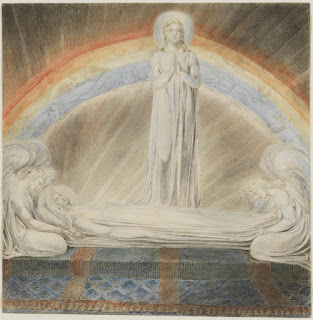Caravaggio, Death of the Virgin, c. 1605
Stumbled across this piece in a book about Rubens.
It was commissioned for a new church in Rome (Santa Maria della Scala) that would be dedicated to a healing miracle by the Virgin Mary. The painting was rejected - probably because it appears to be mostly a grim tragedy. Rubens was in Rome at the time and he advised his patron, the Duke of Mantua, to snap it up.
Isn't it the very antithesis of the buoyant frivolity of Rubens?
You've got to admire Rubens for singling it out for praise.
These drapes are so poignant - and a bit scary.
Strasbourg Cathedral, Death of the Virgin, 1230
The subject matter has been visited many times in Christian art from the Middle Ages to the 17th Century. Typically, as with most Marian art, the pieces share the comfort of faith.
This piece says: "All of us love the Virgin"
Not surprisingly - Caravaggio's version is an outlier.
No comfort there - just sorrow and dread.
These details were taken from a plaster cast made nearly 700 years later.
They allow for a much better photographic presentation of detail - which, in this case, is gorgeous.
A masterpiece of world art.
I wish my local art museum had a plaster cast of it.
Chartres Cathedral, 1200-1250
Oh, those chatty apostles!
I’m not sure the dying woman here is shown appreciating the uproar.
Giotto, Dormition of the Virgin, 1310, 70"X30"
Sculpture has a spatial presence that no painting can ever match.
But paintings can feel more visionary,
especially with a gold background.
Welcome to Heaven.
Master of Heiligenkreuz, c. 1400, 29"x24’
Once again the poor Virgin is
beseiged by all these super intense guys.
Can’t a lady die in peace?
Apparently northern painters allow for some emotional distance between Christ’s mother and his devoted followers.
Fra Angelico: Dormition of the Virgin, 1425-35, 24"x15"
Even more heavenly and dream-like.
The mother and the disciples respectfully collaborate in a divine drama.
Note: "Dormition" rather then "death" is often in the title.
Who wants their divine mother to be dead - even for an instant ?
Andrea Mantegna, Death of the Virgin, 1462-64, 21"x 17"
Definitely more earthbound than Fra Angelico. We are well on our way to Caravaggio.
The lakes surrounding the Ducal Palace of Mantua are in the background.
Petrus Christus, Death of the Virgin, 1460-65, 67"x54"
Those apostles in the foreground seem at least as important as the Virgin behind them. Possibly they are portraits of donors. Yet still there is certainly a sense of wonder here.
There is magic in the ordinary.
Hugo Van Der Goes, Death of the Virgin, 1472-80
I've read commentary that points out how each apostle has a different reaction.
And compared with the sculpture at Strasbourg, they all feel isolated, rather than a family.
Couldn’t this be a death bed scene for anybody ? — except for the eruption of the divine in the upper corner.
The piece makes me feel queasy - uncomfortable.
The circular heavenly vision is a sinking bubble about to burst.
Vivarini, Death of the Virgin, 1484, 74"x59"
A miraculous moment - full stop.
Many Eastern icons are this way.
So many discrete, sharply defined volumes.
So sculptural.
Russian, Dormition of the Mother of God, 1523-1550, 26"x20", National Museum, Stockholm
It's very difficult to find images of original icons on the internet. Mostly you find bespoke copies being sold (at very reasonable prices). It's a cottage industry.
The above has the magic and wonder that I seek from this genre.
Eglise Saint-Pierre de Montfort-l’Amaury, 16th c.
Not the intense, sweet mystery of the window from Chartres,
but the achievement of such dynamic spaciousness,
despite all those black, horizontal structural elements,
seems like a miracle itself.
Michael Coxie, Death of the Virgin, 1550-1570, 81"x71"
A skillful painter of pieces that totally bore me.
I'm getting drowsy, even as I write this.
Heavy, sodden, full of information I don't care about.
Carlo Saraceni, Death of the Virgin, 1610, 180"x107"
This was the piece that went into Santa Maria della Scala instead of the Caravaggio.
I can understand why Caravaggio was rejected -
but this piece is so tiresome.
I recall the words of Claudius (Hamlet)
"Words without thoughts never to heaven go"
Poussin, Death of the Virgin, 1623, 80"x 54"
This one feels much more about painterly style than subject matter.
Poussin was 29 when he painted it - and some parts feel awkward.
(like the stiff dead hand of the stiff dead Virgin)
But elsewhere - there is so much electricity.
I suppose I'd rather him be uneven than staid.
Victor of Crete, Dormition of the Virgin, 1650-90, 17"x14"
I'm sure there are hundreds of icons on this subject
that are as thrilling as this one.
But they are so hard to find online.
This one is burning with passion.
William Blake, Death of the Virgin, 1803, 15"
Blake's visual language is so distant from everything else in this post.
I find it anemic - but I can see how others might see it as highly spiritual - especially in the context of his poetry.

























No comments:
Post a Comment